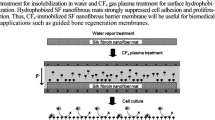Abstract
Due to the outstanding stability, biocompatibility, and permeability, perfluorosulfonic acid (PFSA) membranes can be used to protect biosensors in biological environment. However, mineralization induced cracking hinders their in vivo applications for long duration. Various methods including anneal, preincubation in FeCl3 solution, and layer-by-layer self assembly were attempted to improve their anti-cracking performance, but only met with limited success. In this study, a new method, namely supercritical carbon dioxide (Sc-CO2) treatment was developed to enhance the anti-cracking performance of PFSA membranes. After being incubated in cell culture medium for 12 weeks, while the pristine membranes undergone intense cracking, their Sc-CO2 treated counterparts kept almost intact. Small-angle X-ray scattering and wide-angle X-ray diffraction results revealed the more perfect structure in the treated membranes. Meanwhile, the crystalline structure of pristine membranes was obviously destroyed after cultivation, whereas the treated membranes exhibited little change. The increased crystallinity and reduced ionic clusters size of the Sc-CO2 treated membranes are responsible to the greatly enhanced anti-cracking performance. In addition, such improvement paves the way for the applications of PFSA membranes in implantable biosensors.




Similar content being viewed by others
References
Turner RFB, Harrison DJ, Rojotte RV (1991) Biomaterials 12:361
Moussy F, Harrison DJ, O’Brien DW, Rajotte RV (1993) Anal Chem 65:2072
Moussy F, Harrison DJ (1994) Anal Chem 66:674
Mǎdǎras MB, Buck RP (1996) Anal Chem 68:3832
Moussy F, Jakeway S, Harrlson DJ, Rajotte RV (1994) Anal Chem 66:3882
Haworth B, Gilbert M, Myers DJB (2005) J Mater Sci 40:955. doi:10.1007/s10853-005-6514-3
Wisniewski N, Reichert M (2000) Colloid Surf B 18:197
Mercado RC, Moussy F (1998) Biosens Bioelectron 13:133
Valdes TI, Moussy F (1999) Biosens Bioelectron 14:579
Galeska I, Chattopadhyay D, Moussy F, Papadimitrakopoulos F (2000) Biomacromolecules 1:202
Galeska I, Chattopadhyay D, Papadimitrakopoulos F (2002) J Macromol Sci A 39:1207
Su LJ, Li L, Li H, Zhang YM, Yu W, Zhou CX (2009) J Membr Sci 335:118
Luan YH, Zhang YM, Zhang H, Li L, Li H, Liu YG (2008) J Appl Polym Sci 107:396
Luan YH, Zhang H, Zhang YM, Li L, Li H, Liu YG (2008) J Membr Sci 319:91
Shang FJ, Li L, Zhang YM, Li H (2009) J Mater Sci 44:4383. doi:10.1007/s10853-009-3658-6
Hensley JE, Way JD, Dec SF, Abney KD (2007) J Membr Sci 298:190
Fujimura M, Hashimoto T, Kawai H (1981) Macromolecules 14:1309
Fujimura M, Hashimoto T, Kawai H (1982) Macromolecules 15:136
Wang F, Li MS, Lu YP, Ge SS (2005) J Mater Sci 40:2073. doi:10.1007/s10853-005-1238-y
Spanos N, Misirlis DY, Kanellopoulou DG, Koutsoukos PG (2006) J Mater Sci 41:1805. doi:10.1007/s10853-006-2952-9
Suzuki S, Grondahl L, Leavesley D, Wentrup-Byrne E (2005) Biomaterials 26:5303
Grøndahl L, Bostrom T, Cardona F, Chiem K, Wentrup-Byrne E (2003) J Mater Sci Mater Med 14:503
Filmon R, Grizon F, Basle MF, Chappard D (2002) Biomaterials 23:3053
Zhu PX, Masuda Y, Koumoto K (2004) Biomaterials 25:3915
Akazawa T, Kobayashi M, Kanno T, Kodaira K (1998) J Mater Sci 33:1927. doi:10.1023/A:1004373809449
Silva CC, Pinheiro AG, Figueiró SD, Góes JC, Sasaki JM, Miranda MAR, Sombra ASB (2002) J Mater Sci 37:2061. doi:10.1023/A:1015219800490
Kamei S, Tomita N, Tamai S, Kato K, Ikada Y (1997) J Biomed Mater Res 37:384
James K, Levene H, Parsons JR, Kohn J (1999) Biomaterials 20:2203
Li SH, Liu Q, de Wijn JR, Zhou BL, Groot K (1997) Biomaterials 18:389
Tanahashi M, Matsuda T (1997) J Biomed Mater Res 34:305
Lim JS, Kim JH (2009) J Mater Sci 44:6398. doi:10.1007/s10853-009-3882-0
Acknowledgements
This work was financially supported by the “12th 5-year” National Key Technologies R&D Program of China (2011BAE08B00), the National Science Foundation of China (21104044), and the Shanghai Leading Academic Discipline Project (No. B202). The authors thank Shanghai Synchrotron Radiation Facility, SSRF, for the SAXS and XRD tests.
Author information
Authors and Affiliations
Corresponding author
Rights and permissions
About this article
Cite this article
Ai, F., Yuan, W.Z., Wang, Q. et al. Enhancing the anti-cracking performance of perfluorosulfonic acid membranes for implantable biosensors through supercritical CO2 treatment. J Mater Sci 47, 3602–3606 (2012). https://doi.org/10.1007/s10853-011-6206-0
Received:
Accepted:
Published:
Issue Date:
DOI: https://doi.org/10.1007/s10853-011-6206-0




